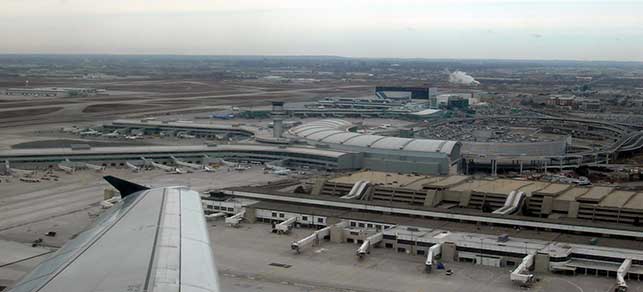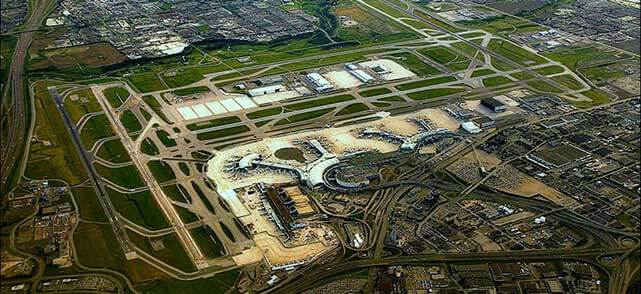For two hours last July, the skies opened. Two major thunderstorms dumped 126 millimetres of rain on Toronto, setting an all-time record for the most rainfall in a single day. Over 300,000 residents experienced power outages, while public transit ground to a halt. At Pearson International Airport, however, the flood control plan went off without a hitch.
“We built our runoff infrastructure to withstand the 100-year storm, and it did just that,” says Toby Lennox, vice-president of corporate affairs at the Greater Toronto Airports Authority (GTAA). Pearson, Canada’s largest airport, is owned and operated by the GTAA.
Water running off of the 19 square kilometres of airport property – much of it paved – was diverted into an extensive system of catchment tanks roughly the size of six football fields. Described by Lennox as similar to the lair of a James Bond villain, this cavernous system then ran the water through fuel separators and other filtering technologies before discharging it into a nearby stream in controlled increments.
Torn between working to meet the air travel demands of a growing city and the constant pollution, space and other constraints facing airports, the GTAA has emerged as an unlikely standard-bearer for sustainability-minded airports.
Viewed as providing an important public asset, disclosure has proved consequential in cementing the GTAA’s reputation. “People should absolutely know what you are doing, no excuses,” says Lennox. He understands that the cost of compliance for smaller companies can sometimes be tricky, but the data gathered plays a key role when planning for future operations. In 2009, the GTAA began to follow the airport supplement guidelines outlined by the Global Reporting Initiative.
In anticipation of climate change “manifesting itself in more severe weather events,” the GTAA has been working with Engineers Canada to identify potential vulnerabilities and determine where greater adaptation measures are needed. The airport is working towards a 60 per cent solid waste diversion goal, while habitat improvements on the nearby Spring and Etobicoke Creeks are ongoing.
For his part, GTAA president and chief executive Howard Eng has internalized many of the lessons learned in his 12 years as executive director of operations at the airport authority in Hong Kong. Based in a city where air quality concerns regularly generate front-page coverage and water resources remain scarce, companies in Hong Kong can’t afford to treat these issues as second-tier. Many households and businesses have even converted to using seawater for the flushing of toilets, in an effort to reduce the strain on freshwater resources.
Some conservation measures have evolved into unlikely revenue sources, including the resale of de-icing fluid. Liners at the Central Deicing Facility capture the glycol-based product, then separate it into high and low concentrations. It is eventually sold as recycled automotive antifreeze. In 2012, 7.6 million litres of fluid was repurposed in this manner. A perforated pipe system under the facility aims to capture any additional liquid that leaks underground.
Aviation currently generates about 2 per cent of global carbon dioxide emissions, while continuing to rise rapidly. Unable to seriously curtail emissions from the aircrafts themselves, the GTAA is working towards the long-term goal of reducing its emissions 20 per cent by 2020. Strategies include pursuing LEED certification for new buildings, expanding efficient heating, ventilation and lighting systems and purchasing more renewable energy.
Lennox concedes that progress has been slow in diversifying transportation choices to and from the airport: “69,000 vehicle trips are made to Pearson a day, but only 2 per cent are from transit. We need to do better.” The Union Pearson Express is the first step, a light rail connecting the downtown to the airport. Currently under construction, it is intended to come online in time for the Toronto Pan Am Games in 2015. Estimates see the train carrying 5,000 people a day.
Eighteen electric vehicle-charging stations have now been installed at the airport for the general public, in addition to the existing facilities for small GTAA vehicles such as baggage carriers.
One big source of congestion and pollution comes from the thousands of employees that commute to work every day. Participation in both the Mississauga and Pearson smart commute programs has had an impact on reducing the number of round trips, but greater investment is needed. The GTAA is now backing civic partners CivicAction and Evergreen in an attempt to elevate transit expansion as a municipal and provincial priority.
The GTAA’s emphasis on corporate social responsibility does not negate its continued participation in a carbon- and resource-intensive business. Explains Lennox: “We have these duelling mandates to grow and serve the city, while at the same time minimizing its impact on the community.
Click here to go back to the ranking landing page.





